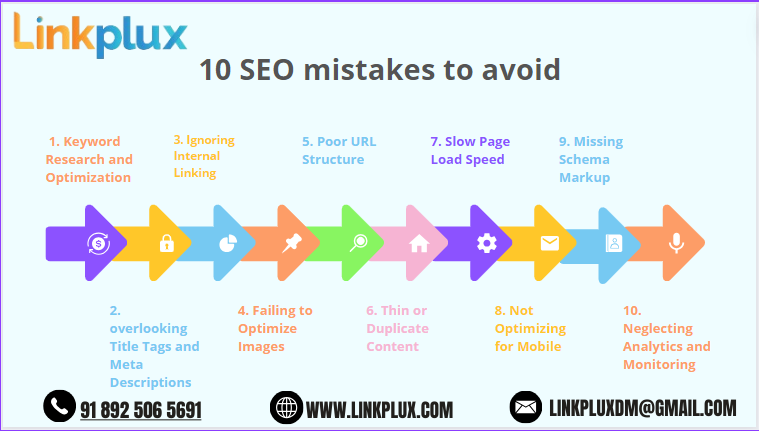In the expansive domain of digital marketing, where Search Engine Optimization (SEO) continually evolves, on-page optimization stands as a cornerstone. It significantly shapes a website's visibility, ranking, and overall success in organic search results. Even seasoned digital marketers often grapple with common on-page SEO errors, hindering efforts to ascend the search engine rankings.

- Lack of Keyword Research and Optimization:
At the core of on-page SEO lies the essential practice of keyword research and optimization. Neglecting these processes can significantly diminish a website's visibility in search results. To sidestep this pitfall, leverage tools such as Google Keyword Planner or SEMrush to identify high-volume, low-competition keywords relevant to your niche. Strategically integrate these keywords into titles, headings, meta descriptions, and content to signal to search engines the topical relevance of your page and improve your chances of ranking for relevant search queries.
- Disregarding Title Tags and Meta Descriptions:
Title tags and meta descriptions serve as the initial impression of a website in search engine results pages (SERPs). Neglecting to optimize these elements can lead to missed opportunities for increased organic traffic. To avoid this misstep, craft compelling, descriptive title tags incorporating target keywords. Similarly, create persuasive meta descriptions that offer a concise summary of your content, integrating relevant keywords and a clear call-to-action to enhance your click-through rate (CTR).
- Oversight of Internal Linking:
Internal linking, often overlooked, forms a foundational aspect of on-page SEO. Ineffective internal linking can impede search engine crawlers' ability to discover and index a website's content, diminishing the overall user experience. To evade this oversight, embed relevant internal links within content to establish a network connecting related pages, instilling a logical hierarchy and flow throughout the website. Utilize descriptive anchor text for internal links to provide context to users and search engines, facilitating navigation and exploration of the site's content.
- Neglecting Image Optimization:
Images play a pivotal role in enhancing the visual appeal and engagement of a website's content. However, overlooking image optimization can undermine on-page SEO efforts. Ensure each image on the website features a descriptive, keyword-rich alt tag accurately delineating the image's content and purpose. Additionally, optimize image file names with relevant keywords and compress images to expedite page load speed without compromising quality.
- Inadequate URL Structure:
A website's URL structure holds significant importance for both user experience and search engine optimization. Lengthy, convoluted, or irrelevant URLs can hinder search engine crawlers' comprehension and navigation of a site's content, diminishing user trust and click-through rates. To avoid this issue, develop URLs that are succinct, descriptive, and incorporate relevant keywords. Utilize hyphens to separate words for improved readability and SEO. Additionally, ensure that URLs accurately represent the content and hierarchy of website pages, facilitating streamlined navigation and enhancing user experience.
- Thin or Duplicate Content:
Content is paramount in SEO, and publishing thin or duplicate content can jeopardize a website's search engine rankings. Prioritize the creation of high-quality, original content that caters to the needs and interests of the target audience. Integrate relevant keywords organically and avoid keyword stuffing. Additionally, employ canonical tags to consolidate duplicate content and signal to search engines the primary version for indexing and ranking.
- Laggard Page Load Speed:
In today's fast-paced digital landscape, users expect websites to load swiftly across all devices and platforms. Suboptimal page load speed can result in higher bounce rates, diminished search engine rankings, and reduced user satisfaction. To avert this misstep, optimize website performance by minimizing server response times, leveraging browser caching, and compressing images and large files. Utilize tools like Google PageSpeed Insights to identify and rectify performance bottlenecks, ensuring a swift and responsive user experience.
- Failure to Optimize for Mobile:
The ubiquity of mobile devices underscores the importance of optimizing websites for mobile users. Neglecting a seamless, responsive mobile experience can lead to lower search engine rankings, heightened bounce rates, and diminished user engagement. To sidestep this pitfall, employ responsive design techniques to ensure websites adapt fluidly to diverse screen sizes and resolutions. Optimize content and navigation for touch interactions, prioritizing mobile-friendly features such as click-to-call buttons and accelerated mobile pages (AMP) to enhance the mobile user experience and improve website visibility and performance in search engine results.
- Oversight of Schema Markup:
Schema markup empowers webmasters to provide search engines with additional context and information about website content, enhancing search results and visibility. Neglecting to implement schema markup can result in missed opportunities to stand out in search engine results pages (SERPs) and provide users with valuable information about website content. Identify pertinent schema markup opportunities, such as product schema for e-commerce websites or FAQ schema for informational content, and deploy structured data markup using standardized schemas and formats. Validate schema markup implementation using tools like Google's Structured Data Testing Tool to ensure search engines interpret and display content effectively in search results.
- Neglecting Analytics and Monitoring for Digital Marketing Services:
Effective on-page SEO necessitates ongoing monitoring and analysis to track performance, identify improvement areas, and effectuate data-driven optimizations. Neglecting to monitor on-page SEO performance and user engagement metrics can result in missed opportunities to enhance website search engine visibility and amplify impact. To avoid this oversight, establish Google Analytics and Google Search Console to monitor key metrics such as website traffic, user behavior, and search performance. Regularly scrutinize analytics data to discern trends, patterns, and areas for enhancement. Utilize insights gleaned to refine on-page SEO strategy, optimize content, and elevate website performance and competitiveness in organic search results.

Conclusion:
In conclusion, steering clear of common on-page SEO blunders is paramount for optimizing website search engine visibility, attracting organic traffic, and realizing online marketing objectives. By avoiding these pitfalls and implementing actionable strategies outlined in this guide, you can fortify on-page optimization endeavors, improve search engine rankings, and drive substantive results for your business or brand. Prioritize user experience, provide valuable, pertinent content, and stay informed about the latest trends and best practices in on-page SEO for sustained success in the dynamic realm of organic search.

No comments yet